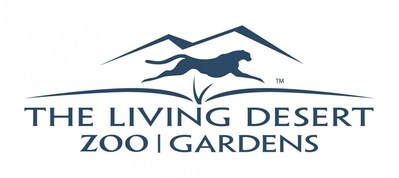Cohort Received Combination of Indoor and Outdoor Rearing—a Headstarting Technique Designed to Increase Survival—From San Diego Zoo Wildlife Alliance and The Living Desert Zoo and Gardens
SAN DIEGO and PALM DESERT, Calif., April 15, 2024 /PRNewswire/ -- Seventy critically endangered Mojave desert tortoises have successfully emerged from their winter burrows after being reintroduced into their native habitat on Edwards Air Force Base in Southern California. San Diego Zoo Wildlife Alliance and The Living Desert Zoo and Gardens, the global authority on desert plant and wildlife conservation, are working in partnership with Edwards Air Force Base, the U.S. Fish and Wildlife Service and the U.S. Geological Survey, using headstarting techniques designed to increase the survival rate for young tortoises. The cohort of young tortoises was the first in the program to be reintroduced into the wild after receiving a combination of an indoor- and outdoor-rearing. Within 24 hours of reentering their native habitat, the tortoises were exhibiting positive natural behaviors by constructing new burrows or modifying existing burrows for shelter. Now, six months later, they have emerged after winter brumation—a state of deep sleep specific to reptiles—and are spending more time basking at burrow entrances. Scientists are currently conducting health assessments and replacing radio transmitters on the tortoises to continue monitoring their success and better understand the juvenile age class.
"We've worked so hard to get here, and we've been through so much together," said Melissa Merrick, Ph.D., associate director of recovery ecology at San Diego Zoo Wildlife Alliance. "We've had to re-strategize, switch plans, react and adapt to so many emerging situations, and we've all done it successfully to get to this point. The second group of young headstart tortoises just arrived from The Living Desert and will spend the next six months with us before joining their predecessors in the wild. It's an exciting time for the program."
Scientists track gravid (egg-carrying) desert tortoises, monitor the adult females as they lay eggs in human care and rear the hatchlings for one to two years. The hatchlings are reared indoors at The Living Desert for six months, and then in a protected outdoor environment at Edwards Air Force Base. By reintroducing the tortoises into native habitat when they are no longer at their most vulnerable, conservationists are giving juvenile tortoises a fighting chance at survival—as evidenced by the success of the first reintroduced cohort. Indoor rearing at The Living Desert enables the tortoises to grow to three to five times the size they would at this stage in their native habitat, making them less vulnerable to predation.
Team members from San Diego Zoo Wildlife Alliance, The Living Desert, and Edwards Air Force Base were present for the heartfelt reintroduction of 70 young tortoises into the Mojave Desert—a full-circle moment for those who cared for the tortoises in their first year of life. More than a year earlier, San Diego Zoo Wildlife Alliance scientists were excavating nests in the middle of the night under emergency circumstances due to a dangerous heat wave, and wildlife care staff at The Living Desert were preparing to receive the tortoises a month early and care for tortoises still in varying stages of hatching.
"Our headstarting program is essential for maximizing the success of young tortoises as we release them into the wild," said James Danoff-Burg, Ph.D., director of conservation at The Living Desert Zoo and Gardens. "Mortality of juvenile desert tortoises is dramatic, often approaching 100% in areas where ravens are overpopulated due to humans providing them food via their open trash containers. The benefits of headstarting are clear when in only six months we can get them to the approximate size of a two-and-a-half-year-old tortoise! Larger tortoises are much more resistant to raven and coyote predation than smaller ones, and our headstarting program ensures that not only normal juvenile mortality rates in the wild are reduced, so is predation. Headstarting makes reintroductions of desert tortoises more successful."
This keystone species in the Southwest United States serves as a prime example of the dangers of a changing climate. In September 2023, the nests of a second headstart cohort—laid in protected outdoor habitats at Edwards Air Force Base—were once again excavated under emergency circumstances. Predatory ants and fly larvae attacked hatchling tortoises as they emerged from their shells. It is believed the historic arrival of Hurricane Hilary created extra moist conditions, leading to a breeding ground for these insects. The surviving tortoises received veterinary care at The Living Desert. The cohort—following in the footsteps of their predecessors—was reared indoors at The Living Desert for the first six months of their life. This month, they will be transferred to the outdoor headstart habitats at Edwards Air Force Base managed by San Diego Zoo Wildlife Alliance, where they will spend the next six months. At approximately one year of age, they will be reintroduced into their native habitat.
Once common throughout the Mojave and Sonoran deserts of California, Nevada and Arizona, desert tortoise populations have declined by an estimated 90% in the last 20 years. California's Mojave desert tortoise, federally protected in the United States since 1989, is categorized as Critically Endangered on the International Union for Conservation of Nature (IUCN) Red List of Threatened Species, and faces threats including habitat loss and fragmentation, disease, human-subsidized predators, and climate change. The U.S. Fish and Wildlife Service's evaluation of population trends from 2018 indicates the species is on a path to extinction under current conditions. However, with continued successful efforts to address the threats they face, there is hope this trend can be reversed.
About San Diego Zoo Wildlife Alliance
San Diego Zoo Wildlife Alliance, a nonprofit conservation leader, inspires passion for nature and collaboration for a healthier world. The Alliance supports innovative conservation science through global partnerships. Through wildlife care, science expertise and collaboration, more than 44 endangered species have been reintroduced to native habitats. Annually, the Alliance reaches over 1 billion people, in person at the San Diego Zoo and San Diego Zoo Safari Park, and virtually in 150 countries through media channels, including San Diego Zoo Wildlife Explorers television programming in children's hospitals in 14 countries. Wildlife Allies members, donors and guests—make success possible.
About The Living Desert Zoo and Gardens
The Living Desert Zoo and Gardens is a nonprofit, accredited member of the Association of Zoos and Aquariums, ensuring the highest standards of all aspects of animal care, education, conservation, public service, and operations. The Zoo is active in conservation research, habitat protection, breeding programs and education initiatives around the world, as well as in its own community. The Zoo has been a top destination in the Palm Springs area for 50 years. Recognized nationally as one of the best zoos in America, The Living Desert is beloved by visitors and is consistently ranked as USA Today's 10Best, 'Best Desert Themed Zoo' by Conde Nast Traveler, and US News and World Report's Best Zoos in the US.
The Living Desert is located at 47900 Portola Ave, Palm Desert, CA 92260. For more information: (760) 346-5694 or visit livingdesert.org.
PRESS ROOM: https://sandiegozoowildlifealliance.org/PR/desert-tortoise-reintroduction
Link includes:
- B-roll of biologists and wildlife care teams reintroducing the desert tortoises into the wild
- Video interviews with team members on the day of the reintroduction
- B-roll and photos of the hatchlings being indoor reared
- Photos of one desert tortoise affectionately named Peter Pan, and a video interview detailing the youngster's story
PERMITTED USE: Images and video(s) are provided to the media solely for reproduction, public display, and distribution in a professional journalistic non-commercial and non-sponsored context in connection with newspaper, magazine, broadcast media (radio, television) or internet media (ad enabled blog, webcasts, webinars, podcasts). Image(s)and video(s)may not be made available for public or commercial download, licensing or sale.
ADDITIONAL LIMITATION: Media acknowledges and agrees that San Diego Zoo Wildlife Alliance specifically does not grant a right to sublicense any image and/or video without the prior express written consent of San Diego Zoo Wildlife Alliance in each instance and at its sole discretion.
REQUIRED CREDIT AND CAPTION: All image and/or video uses must bear the copyright notice and/or be properly credited to the relevant photographer, as shown in the image metadata, and must be accompanied by a caption that makes reference to the San Diego Zoo and/or San Diego Zoo Safari Park. Any uses in which the image and/or video appears without proper copyright notice, photographer credit and a caption referencing the San Diego Zoo, San Diego Zoo Safari Park, and/or San Diego Zoo Wildlife Alliance are subject to paid licensing.
AP PERMITTED USE: Specific to the Associated Press ("AP") only, San Diego Zoo Wildlife Alliance has provided to the AP one or more photograph(s)and/or video(s) for distribution by the AP to its subscribers and customers solely for editorial publication. San Diego Zoo Wildlife Alliance is the sole copyright owner of the photograph(s)and/or video(s)furnished to AP for editorial publication by AP and its subscribers and customers in all media now known or hereafter created. Said content is a factually accurate rendering of what it depicts and has not been modified or augmented except for standard cropping and toning.
CONTACT:
San Diego Zoo Wildlife Alliance
Public Relations
619-685-3291
[email protected]
sdzwa.org
The Living Desert Zoo and Gardens
[email protected]
livingdesert.org
SOURCE San Diego Zoo Wildlife Alliance

WANT YOUR COMPANY'S NEWS FEATURED ON PRNEWSWIRE.COM?
Newsrooms &
Influencers
Digital Media
Outlets
Journalists
Opted In








Share this article